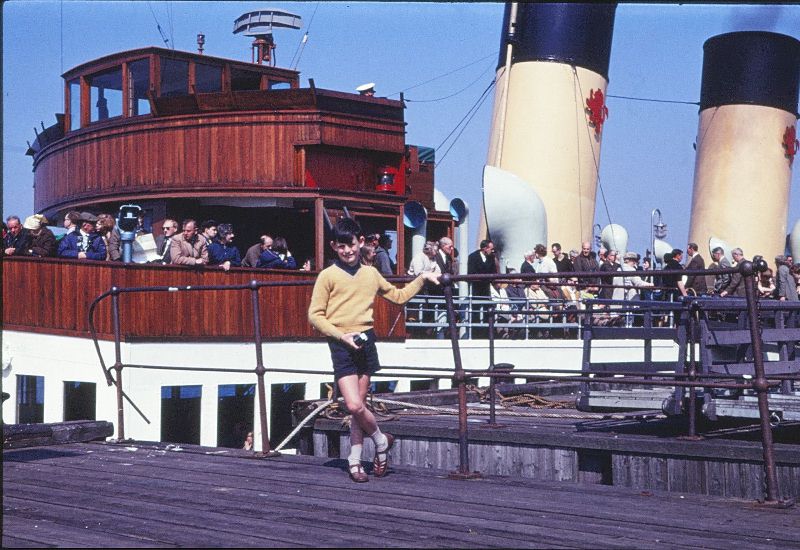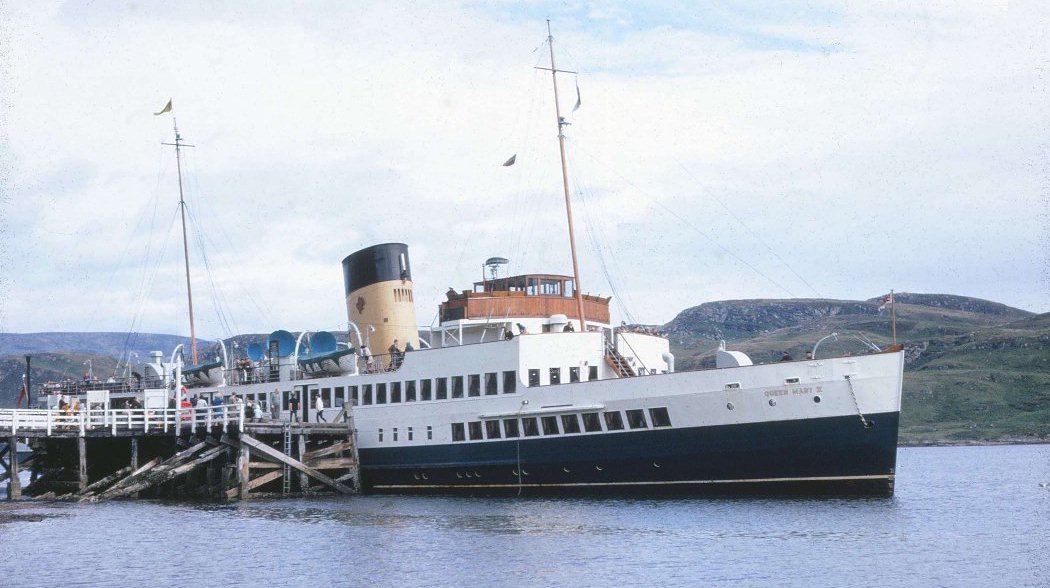
Clyde Turbine Steamers

Above : The only survivor of the fleet : Queen Mary seen at Tighnabruaich in 1967 courtesy of Jake Dale
Queen Mary returned to Scotland under tow arriving on 15th May 2016 to start work to prepare her for a new static role as a heritage attraction in Glasgow. After 35 years away from the Clyde there is now a chance that the turbine steamer, the last of her type in the world, will have a secure future. She might one day be returned to some degree of service, but at present is an empty shell, having been converted for use as a restaurant in London in 1987-88, where she served for almost 21 years. Click on the vessel link below for more
Queen Alexandra, later Saint Columba (1912-1958)
Duchess of Montrose (1930-1964)
Duchess of Hamilton (1932-1970)
Queen Mary, later Queen Mary II (1933-1977)
Marchioness of Graham (1936-1958)
Click on vessel name for more. Dates are first/last main Clyde seasons, not necessarily
launch/disposal/scrapping dates.
The turbine principle, whilst understood for many hundreds of years,
even going back to Archimedes in the 3rd century BC, had
not
been applied in any practical use in the Industrial Revolution until Charles
Parsons experimented with it for power generation purposes in the 1890s. The
fore-sighted engineer appreciated that it might be used for propulsion in a
marine environment and built a demonstration ship, the steam yacht "Turbinia"
in 1894. Turbinia achieved unexpectedly high speeds and got the perfect
opportunity to show its paces at the Naval Review off Spithead in 1897. In
front of all the leading admirals of the Royal Navy she outpaced all other
vessels on display. It was not long before the Admiralty and Parsons, having
formed the Parsons Marine Steam Turbine Company, signed a contract for a new
vessel for the Navy, a 210 foot long torpedo boat which was delivered in late
1899 and caused great satisfaction when she achieved over 37 knots on
trial.
News of this reached the famous Clyde shipbuilders, William Denny
& Co who were interested in developing a turbine powered merchant ship.
The naval torpedo boat "Viper" was similar in size to a large Clyde Steamer
and it seemed sensible to use the local excursion fleet as a test-bed. None
of the main established operators were prepared to jointly finance a
demonstration vessel with Parsons, only Captain John Williamson, an
independent operator took the risk and the Turbine Steamers Syndicate was
then established for this purpose.
37 knots far exceeded the pace of
all other Clyde Steamers : 17 knots was pretty close to the maximum speed
that existing vessels could achieve. There was considerable scope for a
vessel with extra speed to undertake the long runs to Campbeltown and
Inveraray and whilst 37 knots would have made the new vessel untouchable, it
was accepted that, to keep the new ship within reasonable capital cost,
expectations would be more modest.
King Edward of 1901, the first Clyde
Steamer of the new century, was launched on May 16th 1901 at Dumbarton and on
trial achieved 18.66 knots and then during a second set of trials on June
24th, achieved a mean speed of 19.7 knots over the Skelmorlie measured mile.
This was still a slight disappointment to the ship's sponsors and she was
sent to the yard of A&J Inglis at Pointhouse, Glasgow for larger
propellers to be fitted. During a further trial on the 28th of June, King
Edward achieved 20.5 knots and was declared ready for public
service. One of King Edward's turbines was preserved by the city of Glasgow
and is displayed at their Riverside Museum (see photo below, with the upper
casing lifted off to reveal the turbine blades).
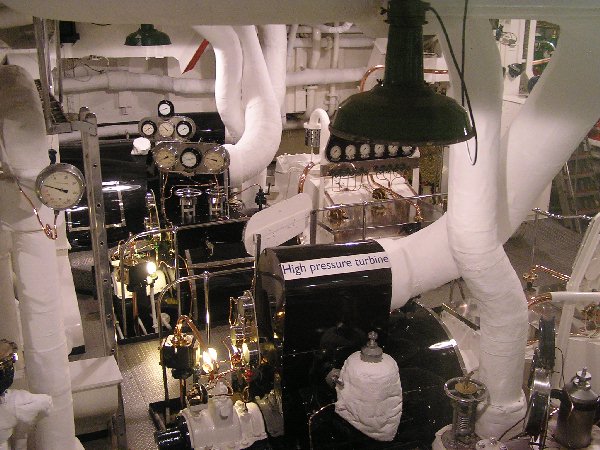
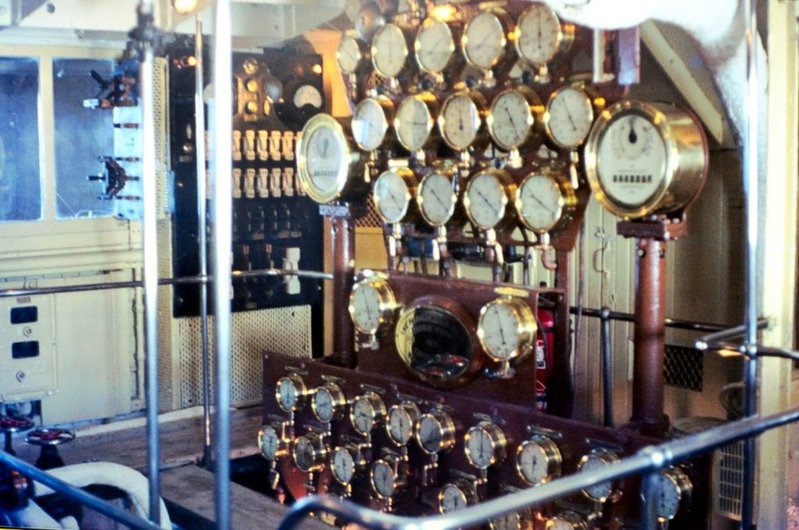
Above : With no moving parts to see, the engines of a turbine steamer were, unlike many reciprocating engined steamers, not an important on-board feature for passenger interest. Nevertheless, the determined enthusiast could marvel at the array of steam gauges at the chief engineer's station. Those belonging to TS King George V of 1926 are seen to good effect in this photo taken in 1972 and shown by kind courtesy of Frank Gradwell.
Review of British Turbine Excursion Steamers
Away from the Clyde, only three operators
ordered turbine steamers and with the exception of the Liverpool and North Wales
trade where two large vessels had a reasonable degree of success, the sole vessels
bought by Paddle Steamer operators P&A Campbell and the General Steam Navigation
Company were notable failures.
TS Empress Queen (P & A Campbell Ltd
,Bristol
Channel and South Coast, England)
TS St Tudno, TS St Seiriol (Liverpool
and North Wales Steamship Company)
TS Kingfisher (General Steam Navigation Company,
Thames
Estuary and South-East England)
TURBINE STEAMERS TODAY
A once-common form of propulsion has now all but disappeared from the passenger sector
Steam
turbines were adopted quickly for larger vessels : short sea crossings such
as from the south of the UK to northern France and from the north-west to the
Isle of Man and Ireland as well as for ocean liners and military vessels (where
the number of ships surviving, both operational and laid-up, remains considerable). These
vessels are out of scope for this website.
The opportunity to sail on a turbine powered passenger ship has, since early 2012
vanished. With the last operational steam turbine ocean liner / cruise ship
SS Oceanic sent to Chinese breakers and the laid up SS The Emerald (originally
built as Santa Rosa) going to Alang, India, only SS Atlantic Star (originally
Fairsky) survived. Built in 1984 in France for Sitmar Cruises, she was the last
ever passenger turbine steamer built, but having been laid up for several years
and with no chance of being reactivated as a steamer, she left Marseille under
tow on March 20th 2013 for demolition at Aliaga, Turkey.
The
only known reasonable opportunities for the public to sail on a turbine
steamer are the preserved US World War II Victory ships "American
Victory", moored as a museum exhibit at Tampa and the Victory ship
"Lane Victory" at Los Angeles. Both are primarily static museum
exhibits but offer infrequent short cruises : American Victory only two
times per year and Lane Victory over three
weekends annually on 1940s-style nostalgia trips to Catalina
Island. It should be noted that these were not passenger excursion
ships and their cruise experience is themed to the original wartime use
of the ships.
Perhaps
the most interesting turbine powered vessel still operational is the
El-Mahroussa, an Egyptian Royal yacht, now owned by the Egyptian Navy
and used on occasion by the Presidents of Egypt including Nasser and
Sadat, attending many important political events, including the USA's
bi-centennial in 1976. Built in 1863-5 as a paddle steamer by
Samuda Brothers in London, she was twice lengthened and the second such
coincided with her being converted to a turbine powered screw steamer
in 1905 by A & J Inglis at Glasgow. In 1869 she was the first ship
to traverse the newly-opened Suez Canal and in 2015 reprised the role
with a new extension to the waterway. She was called El-Horriya from
1952 until 2000.
Static
preservation
A handful
of liners have been saved as hotels (RMS Queen Mary, SS Rotterdam, and MV (ex-SS) Queen Elizabeth II). Both Queens were
built on the Clyde. A number of military vessels have been preserved as museum
ships, as has the former British Royal Yacht, Britannia, which is moored at
Leith (Edinburgh) and is seen below in a photo from 2015 by kind courtesy of Kenny Whyte
The Clyde Turbine steamer Queen Mary, which became a restaurant ship before being finally laid up, has now been returned to Scotland and a charitable trust is working on her restoration and opening as a static exhibit, albeit much changed internally and missing her engines. The world's first turbine vessel, Turbinia, also remains as a museum exhibit - at the Discovery Museum in Newcastle-upon-Tyne, albeit out of the water and in the museum's exhibition hall
One example of a British short sea ferry, TS Duke of Lancaster
(built in 1956 for Irish Sea services, and converted to accept cars in
1970) survives, beached on the North Wales coast at
Llanerch-y-Mor. Groups exist which are intent on saving these vessels
but have been unable to make any progress.
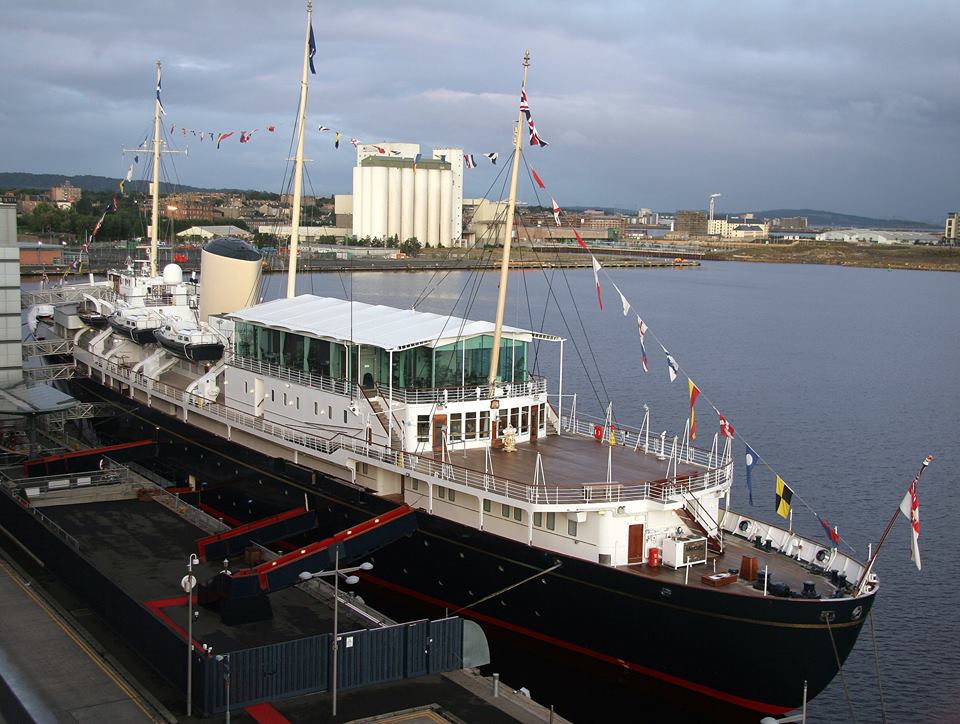
A survivor : but now with diesel engines
Superyacht
Nahlin, now owned by vacuum-cleaner designer and industrial magnate Sir James
Dyson, began life in 1930 as a turbine steamer (with 4 Brown Curtis turbines)
built on the Clyde by John Brown Engineering (yard number 533), builders of
Cunard's "Queen" class liners, for the heiress Lady Yule. In 1937
she was sold to the Romanian royal family and renamed Luceafarul and she became
Libertatea in 1948 as she became a museum, then restaurant under the Ministry
of Culture of the Romanian peoples' republic. In 1999, in a near derelict condition,
she returned to the UK for restoration in Liverpool and was briefly owned by
Sir Anthony Bamford as she changed hands more than once. In 2005 she was moved
to Rendsburg in Germany under Dyson's ownership and underwent a major restoration,
reported to be in the region of GBP 25 million in cost, to become a luxury
yacht once more. The renovation saw diesel-electic engines replacing her
turbines. A small steam engine was retained to operate the windlass and winch.
The ship is not open to the public
RECOMMENDED READING
Turbine Excursion Steamers - A History : by Alistair Deayton and Iain Quinn. ISBN 10 : 1445619377 - ISBN 13 : 978-1445619378
All
you need to know is in this comprehensive volume published in 2013 and
written by two well-known and acknowledged experts on Clyde
Steamers
COPYRIGHT AND REUSE ISSUES OF PHOTOGRAPHS AND TEXT ON THIS WEBSITE
![]() 2000-2021 www.paddlesteamers.info and
Gordon Stewart.
2000-2021 www.paddlesteamers.info and
Gordon Stewart.
All photographs displayed are with the permission of the acknowledged photographer
but are not to be copied for re-use for any other website or publication without
the specific authorisation of the photographer. You are welcome to use the text
from this website as a research source and basis for your own work but it should
not be copied and republished elsewhere verbatim or only slightly altered.
Information presented is from the webmaster's own review of previously published material or from material submitted to the webmaster for publication. If anything posted is factually incorrect and you are in possession of more accurate information, please let me know and I will make the appropriate corrections / improvements to the text.
All
material on www.paddlesteamers.info
is ![]() www.paddlesteamers.info and Gordon Stewart or the individual photographer where acknowledged.
Photos not otherwised attributed are by Gordon Stewart
www.paddlesteamers.info and Gordon Stewart or the individual photographer where acknowledged.
Photos not otherwised attributed are by Gordon Stewart
ASSOCIATED WEBSITES


InTramCities : Network Photography in Tramway Cities
Gordon Stewart travels regularly throughout Europe to create what is perhaps the finest tramway photograph resource on the internet. Although trams are the focal point and common thread throughout, it is where they are running which provides the diversity and interest in his photos. As well as city centres with their grand architecture, Gordon takes you to less well-known suburbs to give a real feel for the tramway city. The photos are becoming an important historical record for those interested in the city itself as well as its trams and also show how trams fit into urban environments to provide an attractive and accessible transportation system.
THE WEBMASTER
Gordon Stewart, based in the United Kingdom : Please e-mail Gordon Stewart on this link
